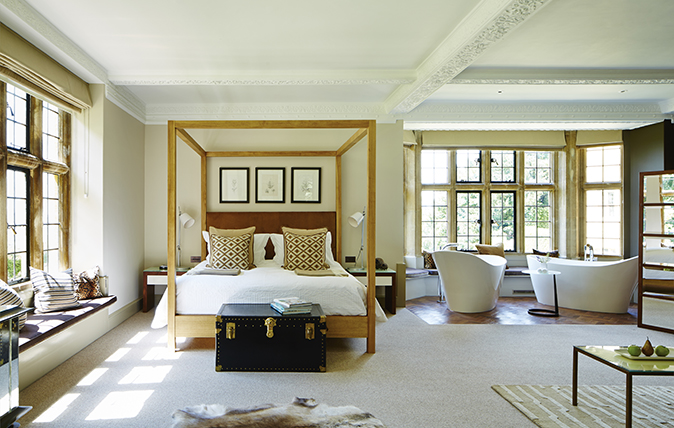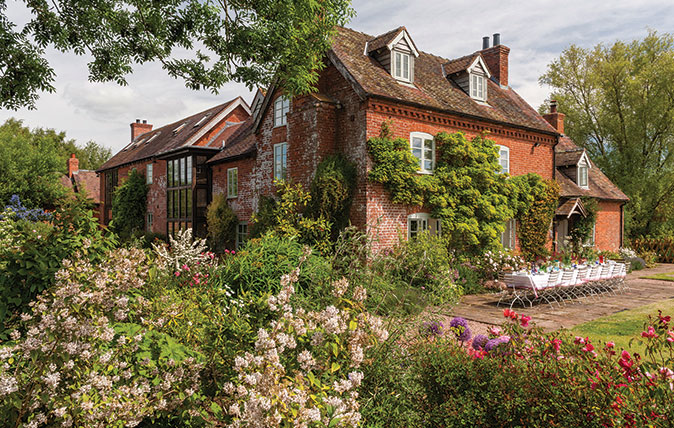Creaking country piles with drafty corridors and leaky roofs are increasingly a thing of the past - today's homes in the country have a very different list of features, many of which you'd normally associate with top-end hotels. Arabella Youens speaks to a pair of experts who explain the phenomenon of the 'super cottage'.
A decade ago, an invitation to a rural bolthole often meant you had to face the prospect of a temperamental boiler, a faint aroma of rising damp and creaking corridors.
However, thanks to the hiking of Stamp Duty, many homeowners who, a decade ago, would have bought a large country house are opting for something more modest and investing the money saved in tax on creature comforts normally associated with boutique hotels or swanky London apartments. Welcome to the world of the ‘super cottage’.
In estate-agent speak, this is known as a ‘pyramid house’: larger on the bottom than it is on top. Room for entertaining is fundamental, but expectations are rather different as to what they might have been a generation ago.
‘Owners certainly want to entertain, but not the hot-and-cold running staff required to achieve it,’ says Lindsay Cuthill of Savills.
‘Ideally, guests can be accommodated in a garden annexe or come for dinner, lunch or brunch, but stay somewhere nearby.’

New Gothic-style fenestration, revealing beautiful views, has helped transform this outbuilding into an elegant summer dining room. ©Hugo Rittson Thomas/Country Life Picture Library
Cotswold-based interior designer Pippa Paton has worked on her fair share of these houses, bringing her well-honed eye for spatial planning to reorganising layouts that were never originally designed with the key concepts of ‘circulation space’ or ‘en-suite’ in mind.
‘Typically, cottages and smaller village houses are made up of a few rooms that lead off a modest entrance hall,’ says Pippa.
‘Rooms need to be opened up to achieve the open-plan kitchen and a dining room large enough to seat 10–12.’
‘I can’t remember the last time I did a house without underfloor heating’
Barn conversions work well for this type of client: ‘With vaulted ceilings and wonderful entertaining space downstairs and not much upstairs, they suit country-house owners looking for low-maintenance living.’
Freezing-cold journeys to the bathroom are definitely out for any self-respecting super cottage. The standard of finish for these projects is now akin to that found in hotels such as Soho House or The Pig, right down to the Aesop-branded soaps in the bathrooms.
‘I can’t remember the last time I did a house without underfloor heating,’ says Pippa.
‘In addition, we’re increasingly being asked to creatively carve out en-suite bathrooms for every bedroom and a dressing room, however small, in the master is becoming a must-have.’

Little expense is spared in the quest for comfort. Four-poster beds (where ceiling heights allow), rain showers and claw-footed baths – the latter in the bedroom, where possible – are further influences of the hotel industry.
‘It makes sense. Where else but in the country do you have the time to have a long, hot soak in the bath?’ asks Pippa.
‘The wishlist is increasing rather than decreasing,’ adds interior designer Emma Sims-Hilditch, who converted a barn in Wiltshire in order to expand her family home. Where space allows, gym or yoga rooms are creeping up the list as are wine cellars and boiler taps in the kitchen.
For those who travel, it’s ever more important that heating and lighting are controlled remotely, says Pippa.

Four poster bed and bathtub in the bedroom? This lovely room at Foxhill Manor in the Cotswolds is now the sort of thing people are putting in their own homes
Gardens have also been given a make-over: a new style of ‘super cottage garden’ has kept Cirencester-based garden designer Sparrow Morgan-Grenville busy for the past 10 years or so. The blousy, high-maintenance cottage gardens of yore are giving way to simpler spaces and planting.
Pippa says that plenty of carefully planned outdoor entertaining space is key; three different alfresco areas are typically carved out of the garden, however small: one for family breakfasts, a bigger one for large-scale entertaining and a ‘cocktail corner’ to catch the final rays of sunshine in the evenings.
Outdoor kitchens are becoming more common, alongside barbecue pits, Kadai fire bowls and Big Green Eggs – the latter doubles as a barbecue and pizza oven.
In another move away from the classic English cottage garden, structure and sculpture feature strongly in the designs.
‘There’s a desire among these clients to spend money locally here in the Cotswolds,’ Pippa explains. ‘I turn to our blacksmith to commission pergolas and arches to introduce a bit of structure, as well as water sculptures by Giles Rayner or designs by the likes of Michael Cooper and David Harber.’

A Robert Myers garden design (Photograph: Alex Ramsey)
Despite this, the passion for classic English blooms isn’t over and cutting gardens – even just a few raised beds planted with dahlias, roses and peonies – are becoming ever more popular. ‘As are flower rooms,’ adds Emma, who’s designed two recently as small extensions to the original house.
‘There’s a discernible passion for growing British flowers and having freshly picked blooms brings an extra special air to the perfect country house.’

Six things you need to know about buying a picture-perfect weekend cottage
We spoke to experts to find out what you need to know about buying a picture-perfect weekend cottage.

10 picture-perfect thatched cottages which are immaculate inside and out
Buying a thatched cottage needn't mean walking into a nightmare of work to do – these delightful places are all

11 stunning character properties for sale at under £400,000
A breathtaking Scottish coastal home and several delightful cottages feature in our latest round-up of genuinely affordable country houses with





